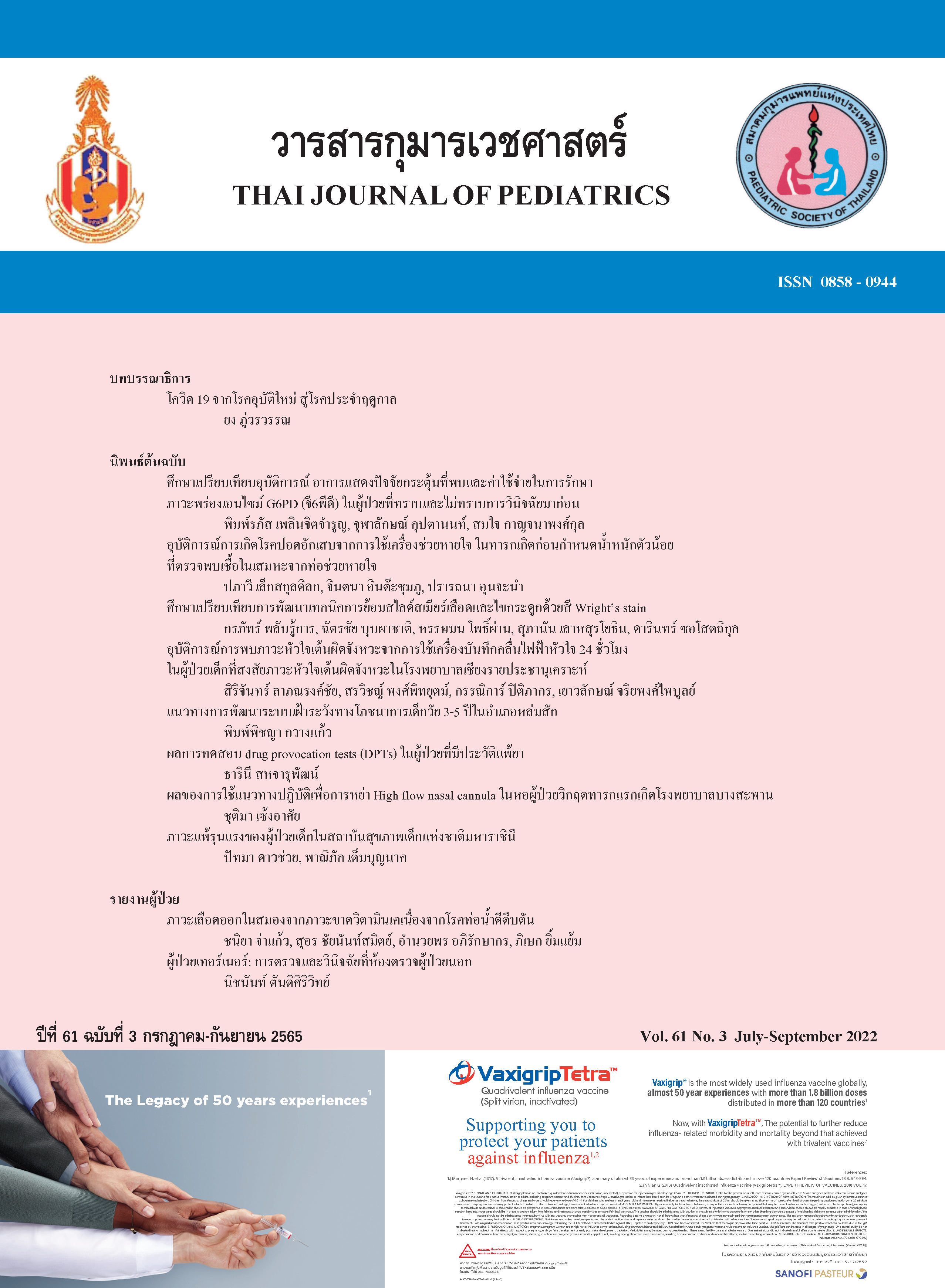ภาวะแพ้รุนแรงของผู้ป่วยเด็ก ในสถาบันสุขภาพเด็กแห่งชาติมหาราชินี
คำสำคัญ:
การแพ้รุนแรง, สาเหตุ, อาการและอาการแพ้รุนแรง, การรักษาบทคัดย่อ
ความเป็นมา: การแพ้รุนแรง (anaptylaxis) เป็นปฏิกิริยาทางภูมิแพ้รุนแรงที่เกิดขึ้นอย่างเฉียบพลันทั่วร่างกาย อาจมีความรุนแรงจนเป็นอันตรายต่อชีวิต อุบัติการณ์ของ anaphylaxis มีแนวโน้มเพิ่มสูงขึ้นโดยเฉพาะในผู้ป่วยเด็ก ซึ่งข้อมูลการศึกษา anaplylaxis ในกลุ่มประชากรเด็กมีน้อยโดยเฉพาะการศึกษาในประเทศไทย
วัตถุประสงค์: เพื่อศึกษาสาเหตุ อาการ การรักษา การดำเนินโรค และภาวะแทรกซ้อนของภาวะanaphylaxis ในสถาบันสุขภาพเด็กแห่งชาติมหาราชินี
วิธีการศึกษา: เป็นการศึกษาวิจัยย้อนหลังเชิงพรรณนา (retrospective descriptive stud) โดยทบทวน
เวชระเบียนของผู้ป่วยเด็กที่มีภาวะ anaphylaxis จากข้อมูลการวินิจฉัยตามรหัส ICD-10 ตั้งแต่เดือนมกราคม พ.ศ. 2550 ถึงเดือนพฤษภาคม พ.ศ. 2564
ผลการศึกษา: พบผู้ป่วยเด็กที่เข้าเกณฑ์การวินิจฉัย anaphylaxis ที่เข้ารับการรักษาในสถาบันสุขภาพเด็กแห่งชาติมหาราชินี ย้อนหลัง 14 ปี จำนวน 200 ราย อายุเฉลี่ย 6.96+4.3 ปี (อายุน้อยที่สุด 4 วันและอายุมากที่สุด 15 ปี 5 เดือน) และพบว่าร้อยละ 48.5 ของผู้ป่วยเด็กมีประวัติโรคภูมิแพ้ร่วมด้วย โดยโรคภูมิแพ้ที่พบมากที่สุดคือ โรคภูมิแพ้จมูก (allergic rhinitis) สาเหตุของ anaphylaxis ที่พบมากที่สุดคือแพ้อาหาร (ร้อยละ 56 รองลงมาคือ ไม่ทราบสาเหตุ (ร้อยละ 16.5) แมลงต่อย (ร้อยละ 14) วัคซีนภูมิแพ้ไรฝุ่น (ร้อยละ 9) และยา (ร้อยละ 7 อาการที่พบส่วนใหญ่คือ อาการทางระบบผิวหนัง (ร้อยละ 96.5) ที่พบมากที่สุดคือ ลมพิษ (urticaria) และบวมที่ชั้นใต้ผิวหนัง (angioedema) อาการที่พบรองลงมาคือ
อาการทางระบบทางเดินหายใจ (ร้อยละ 76.4) ส่วนใหญ่มาด้วยอาการหายใจลำบาก และ อาการหลอดลมตีบ ยกเว้นในกลุ่มเด็กเล็กอายุ 0-2 ปี ที่พบอาการทางระบบหายใจน้อยที่สุดและมักจะมาด้วยอาการคล้ายไข้หวัด ผู้ป่วยร้อยละ 93.4 ได้การรักษาด้วยยา adrenaline พบภาวะ anaphylaxis ที่เกิดขึ้นในระยะที่สอง (biphasic anaphylaxis) 7 ราย (ร้อยละ 4.6
สรุป: anaphylaxis พบมากที่สุดในช่วงวัยเรียน อาหารเป็นสาเหตุหลัก โดยเฉพาะอาหารทะเลพบมากที่สุด
แต่ในเด็กเล็กพบว่า anphylaxis มักมีสาเหตุและอาการแสดงที่ต่างจากช่วงอายุอื่น
Downloads
เอกสารอ้างอิง
Cardona V, Ansotegui IJ, Ebisawa M, ElGamal Y, Fernandez Rivas M, Fineman S, et al. World allergy organization anaphylaxis
guidance 2020.WorldAllergy Organ J. 2020;13:100472.
Shaker MS, Wallace DV, Golden DBK, et al. Anaphylaxis-a 2020 practice parameter update, systematic review, and Grading of Recommendations, Assessment, Development and Evaluation (GRADE) analysis. J Allergy Clin Immunol. 2020; 145:1082-123.
คณะทำงานเพื่อรักษาและป้องกันการแพ้ชนิดรุนแรงแห่งประเทศไทย.แนวทางเวชปฏิบัติสำหรับการดูแลผู้ป่วยที่มีการแพ้รุนแรง.กรุงเทพ;2560.
Anagnostou K. Anaphylaxis in Children: Epidemiology,RiskFactors andManagement. Curr Pediatr Rev. 2018; 14:180–6.
Cohen N,CapuaT, Pivko D,Ben-Shoshan M, Benor S, Rimon A. Trends in the diagnosis and management of anaphylaxisin a tertiary care pediatric emergency department. Ann AllergyAsthma Immunol. 2018; 121:348-52.
Jirapongsananuruk O, Bunsawansong W, Piyaphanee N, Visitsunthorn N,Thongngarm T, Vichyanond P. Features of patients with
anaphylaxis admitted to a university hospital. Ann Allergy, Asthma Immunol [Internet]. 2007; 98:157–62.
Manuyakorn W, Benjaponpitak S, Kamchaisatian W, Vilaiyuk S, Sasisakulporn C, Jotikasthira W. Pediatric anaphylaxis: triggers, clinical features, and treatment in a tertiary-care hospital. Asian Pac J Allergy Immunol. 2015; 33:281-8.
Rangkakulnuwat P, Sutham K, Lao-Araya M. Anaphylaxis: Ten-year retrospective study from a tertiary-care hospital in Asia. Asian
Pac J Allergy Immunol. 2020; 38:31-9.
Techapornroong M. Original article nAnaphylaxis : a ten years inpatient retrospective study. 2001; 262–9.
Yoon L, Kim BR, Lee JY, et al. Clinical features of anaphylaxis according to age in a single university hospital in Korea. Asian Pac J Allergy Immunol. 2017; 35:96-101.
Lee S, Hess EP, Lohse C, Gilani W, Chamberlain AM, Campbell RL. Trends, characteristics, and incidence of anaphylaxis in 2001-2010: A population-based study. J Allergy Clin Immunol. 2017; 139:182-188.
Poachanukoon O, Paopairochanakorn C. Incidence ofAnaphylaxisin the Emer-gency Department: A 1-Year Study in a University Hospital. Asian Pac J Allergy Immunol.2006.
Civelek E, Erkocoglu M, Akan A, et al. The Etiology and Clinical Features of Anaphylaxis in a developing country: A nationwide survey in Turkey. Asian Pac J Allergy Immunol. 2017; 35:212-9.
Worm M, Eckermann O, Dölle S, Aberer W, et al. Triggers and treatment of anaphylaxis: An analysis of 4000 cases from Germany,
Austria and Switzerland. Dtsch Arztebl Int.2014; 111:367–75.
Sheikh F, Amin R, Rehan Khaliq AM, Al Otaibi T, Al Hashim S, Al Gazlan S. First study of pattern of anaphylaxis in a large tertiary care hospital in Saudi Arabia. Asia Pac Allergy. 2015; 5:216.
Inoue N, Yamamoto A. Clinical evaluation of pediatric anaphylaxis and the necessity for multiple doses of epinephrine. Asia PacAllergy. 2013; 3:106.
Liew WK, Chiang WC, Goh AE, et al. Paediatric anaphylaxis in a Singaporean children cohort: changing food allergy triggers over time. Asia Pac Allergy. 2013;3:29.
Samady W, Trainor J, Smith B, Gupta R. Food-induced anaphylaxis in infants and children. Ann Allergy Asthma Immunol. 2018; 121:360-5
Piboonpocanun O, Palaga T. Anaphylaxis, asthma and supplementary medicines, looking from West to East. Asian Pacific J Allergy Immunol. 2015; 33:1–2.
Lertnawapan R, Maek-a-nantawat W. Anaphylaxis and biphasic phase in Thailand: 4-year observation. Allergol Int. 2011;60:283-9.
Lieberman P. Biphasic anaphylactic reactions. Ann Allergy Asthma Immunol. 2005; 95:217-26; quiz 26, 58.
Sricharoen P, Sittichanbuncha Y, Wibulpolprasert A, Srabongkosh E, Sawanyawisuth K. What clinical factors are associated with biphasic anaphylaxisin Thai adult patients.Asian Pac JAllergy Immunol.2015; 33:8–13.
Novembre E, Cianferoni A, Bernardini R, et al. Anaphylaxis in children: clinical and allergologic features. Pediatrics. 1998;101:E8.
Olabarri M, Vazquez P, Gonzalez-PosadaA, et al. Risk Factorsfor SevereAnaphylaxisin Children. J Pediatr. 2020; 225:193-7 e5.
UppalaR, Phungoen P, Mairiang D,Chaiyarit J, Techasatian L. Pediatric Anaphylaxis: Etiology and Predictive Factors in an Emergency Setting. Glob Pediatr Health.2021; 8:2333794X211011301.
Gaspar Â, Gaspar Â, Santos N, et al.One-year survey of paediatric anaphylaxis in an allergy department. 1998.
Grabenhenrich LB, Dölle S, MoneretVautrin A, et al. Anaphylaxis in children nand adolescents: The EuropeanAnaphylaxis Registry. J Allergy Clin Immunol. 2016;137:1128-1137.
Jiang N, Xu W, Xiang L. Age-related differences in characteristics of anaphylaxis in Chinese children from infancy to
adolescence. World Allergy Organ J. 2021;14:100605.
Kemp SF, LockeyRF.Anaphylaxis:Areview of causes and mechanisms. J Allergy Clin Immunol. 2002; 110:341–8.
Ratnarajah K, Clarke AE, McCusker C, et al. Anaphylaxis as a presenting symptom of food allergy in children with no known
food allergy. J Allergy Clin Immunol Pract.2020; 8:2811-3.
Jeon YH, Lee S, Ahn K, et al. Infantile Anaphylaxis in Korea: a Multicenter Retrospective Case Study. J Korean Med Sci. 2019; 34:e106.
TejedorAlonso MA, Moro Moro M, Mugica Garcia MV, et al. Incidence of anaphylaxis in the city ofAlcorcon (Spain): a populationbased study. Clin Exp Allergy. 2012; 42:578-89.
Cardinale F, Amato D, Mastrototaro MF, Caffarelli C, Crisafulli G, Franceschini F, et al. Drug-induced anaphylaxis in children. Vol. 90, Acta Biomedica. Mattioli 1885; 2019. p. 30–5.
Farbman KS, Michelson KA. Anaphylaxis in children. Vol. 28, Current Opinion in Pediatrics. Lippincott Williams and Wilkins;
p. 294–7.
Ratanaprug C , Srisuwatchari W, Jirapongsananuruk O, Visitsunthorn N, Pacharn P. Carrying rates of epinephrine devices in children with food-induced anaphylaxis. Asia Pacific Allergy. 2019; 9.
Lee JM, Greenes DS. Biphasic anaphylactic reactions in pediatrics. Pediatrics. 2000; 06:762-6.
Ikegawa K, Morikawa E, NigoA, Hataya H, Akasawa A. Epidemiology of anaphylaxis and biphasic reaction in Japanese children. Acute Med Surg. 2021; 8:e688.
LiuX,LeeS,LohseCM,HardyCT,Campbell RL. Biphasic Reactions in Emergency Department Anaphylaxis Patients: A Prospective Cohort Study. J Allergy Clin Immunol Pract. 2020; 8:1230-8.
ดาวน์โหลด
เผยแพร่แล้ว
รูปแบบการอ้างอิง
ฉบับ
ประเภทบทความ
สัญญาอนุญาต

อนุญาตภายใต้เงื่อนไข Creative Commons Attribution-NonCommercial-NoDerivatives 4.0 International License.



